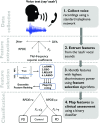Developing a large scale population screening tool for the assessment of Parkinson's disease using telephone-quality voice
- PMID: 31153319
- PMCID: PMC6509044
- DOI: 10.1121/1.5100272
Developing a large scale population screening tool for the assessment of Parkinson's disease using telephone-quality voice
Abstract
Recent studies have demonstrated that analysis of laboratory-quality voice recordings can be used to accurately differentiate people diagnosed with Parkinson's disease (PD) from healthy controls (HCs). These findings could help facilitate the development of remote screening and monitoring tools for PD. In this study, 2759 telephone-quality voice recordings from 1483 PD and 15 321 recordings from 8300 HC participants were analyzed. To account for variations in phonetic backgrounds, data were acquired from seven countries. A statistical framework for analyzing voice was developed, whereby 307 dysphonia measures that quantify different properties of voice impairment, such as breathiness, roughness, monopitch, hoarse voice quality, and exaggerated vocal tremor, were computed. Feature selection algorithms were used to identify robust parsimonious feature subsets, which were used in combination with a random forests (RFs) classifier to accurately distinguish PD from HC. The best tenfold cross-validation performance was obtained using Gram-Schmidt orthogonalization and RF, leading to mean sensitivity of 64.90% (standard deviation, SD, 2.90%) and mean specificity of 67.96% (SD 2.90%). This large scale study is a step forward toward assessing the development of a reliable, cost-effective, and practical clinical decision support tool for screening the population at large for PD using telephone-quality voice.
Figures





References
-
- Arora, S. , Baig, F. , Lo, C. , Barber, T. R. , Lawton, M. A. , Zhan, A. , Rolinski, M. , Ruffmann, C. , Klein, J. C. , Rumbold, J. , Louvel, A. , Zaiwalla, Z. , Lennox, G. , Quinnell, T. , Dennis, G. , Wade-Martins, R. , Ben-Shlomo, Y. , Little, M. A. , and Hu, M. T. (2018a). “ Smartphone motor testing to distinguish idiopathic REM sleep behavior disorder, controls, and PD,” Neurology 91, e1528–e1538. 10.1212/WNL.0000000000006366 - DOI - PMC - PubMed
-
- Arora, S. , Visanji, N. P. , Mestre, T. A. , Tsanas, A. , AlDakheel, A. , Connolly, B. S. , Gasca-Salas, C. , Kern, D. S. , Jain, J. , Slow, E. J. , Faust-Socher, A. , Lang, A. E. , Little, M. A. , and Marras, C. (2018b). “ Investigating voice as a biomarker for leucine-rich repeat kinase 2-associated Parkinson's disease,” J. Parkinsons Dis. 8, 503–510. 10.3233/JPD-181389 - DOI - PubMed
-
- Åström, F. , and Koker, R. (2011). “ A parallel neural network approach to prediction of Parkinson's disease,” Expert Syst. Appl. 38, 12470–12474. 10.1016/j.eswa.2011.04.028 - DOI
-
- Bishop C. M. (2007). Pattern Recognition and Machine Learning ( Springer-Verlag, New York: ).
Publication types
MeSH terms
Grants and funding
LinkOut - more resources
Full Text Sources
Medical

